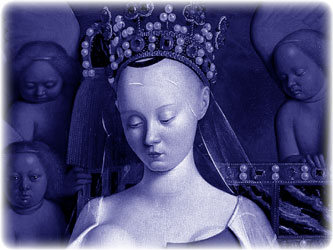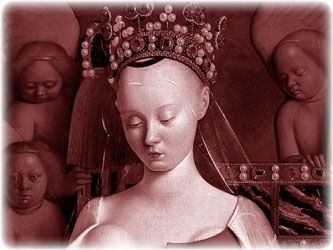Are you looking for an original interpretation of the Melun Diptych? Fantastic. Here you will find four different interpretations, all in the form of a poem!
Of course, you might be asking just what is the Melun Diptych. It’s simply one of the most stunning and perplexing paintings ever painted. It was a religiously themed painting, painted at the end of the 15th century. Yet despite the painting’s religious theme, the Melun Diptych is a surprisingly sensuous and erotic work of art. You can view the painting here: Melun Diptych painting.

Melun Diptych: Background
Okay, let’s start with the word, diptych. What does that mean? It simply means two objects of art, in this case two paintings, which are attached together and form a pair. The Melun Diptych is a particularly famous diptych, and it is from the town of Melun, hence the name, the Melun Diptych.
The Melun Diptych was commissioned by Étienne Chevalier to hang either over his own tomb or that of his wife’s. The Melun Diptych was painted by Jean Fouquet. While we have a selection of some of Fouquet’s work, and among them at least one other sensuous painting—that of Agnès Sorel, nothing matches the power and evocativeness of the Melun Diptych.
In our interpretative poems, we will mostly refer to the right half of the diptych, the left half being fairly plain and drab by comparison. While ostensibly the painting is of the Madonna and the Christ child, there are many oddities in the painting. Just to cite one, the baby has not been circumcised, which given the times and circumstances is quite strange. But more interestingly, the model for the painting was King Charles VII’s famous lover, Agnès Sorel!
You might be asking who was Charles VII. He is the king we most associate with Joan of Arc. Charles VII was the king that she fought for, which adds all more interesting intrigue to the entire era in which the painting was painted.
We have long been admirers of this stunning painting, and here we offer four poems that make a meager attempt at appreciation and interpretation. We hope in the future to revisit this topic again, and perhaps to offer some new poems!

Melun Diptych: A Descriptive Poem
Our first poem focuses on trying to get a little bit into words at least some of the beauty of the right panel of the Melun Diptych.
They asked him to paint the virgin Mary;
They should have been a little wary;
He painted instead the king’s lover;
And her left breast was without any cover.
She sits there so calmly
Without a hint of the balmy;
In the queen’s chair
She gives off such an air.
The jewel encrusted crown
Does not weigh her down;
Her hair has been smoothly shaved clean,
And she certainly looks the part of the queen.
Then there is her beautiful lunar globe,
Barely touched by an ermine robe—
Her breast is so perfectly round;
I truly think she should’ve been crowned.
More erotic, than tender,
She’s a lascivious splender;
More seductive, than maternal,
She’s impressively infernal.
And that boy that sits on her lap
Pointing down deep into that flap,
He could care less about her nipple
For he knows what’s beneath that ripple.
There’s such a detached air
As he sits there so bare;
This naked rotund prince,
He’ll never bear a wince.
Then there is that eloquent gold chain,
The umbilical cord that leads back to her pain,
Draped over her pubic region,
The thoughts it inspires are legion.
The queen and her babe are as white as snow;
But as for the rest of the painting it so does glow;
Deep shades of red and a deeper blue,
Make you dread what’s so utterly true.
The scorching hosts of cherubim,
Mingle with some chilly seraphim;
Faces pensive and full of affection,
All of them so deep in reflection.
And then there is her magnificent face,
No seductive virgin ever had such grace;
And here I must admit that all my words,
They can only scatter like birds.

Melun Diptych: Attempts at Interpretation
Each of the following two poems is a bit of a meditation over the right panel of the Melun Diptych. Each poem celebrates its unique beauty in a slightly different manner.
You forever and only you—
You make me feel so blue;
I stare at your inscrutable face;
I languish in your palpable grace
For hours on end,
I can’t unbend;
I feel your cool presence;
It’s a delightful pleasance.
If only you’d grasp my plea,
If only I had the golden key;
For try as I might
I’m lost in your sight.
To reach up and touch you—
That is what I wish to do;
Yet always you escape me,
You always fly free.
I hear your breathing,
My God, you are seething;
Your breast gently rises and falls,
Oh, I can hear the calls.
You whisper out to me,
A soft voice of glee;
I lean in to hear your secrets—
Such beautiful little secrets.
The temptation is just too great,
There is a thirst I must sate;
I’m tired of this doubt;
I want to reach out—
I’ll gently lift your chin
And then I’ll peer within—
I’ll let these lips drift closer yet,
And then at last we’ll be well met.
It’s a deliberate violation;
It’s just another attempt by you
At some type of impure intercession—
But what can anyone make
Of the transfiguration of the soul.
You might seek to change the alignment
Of that heavenly constellation;
And then you might try
To reach out and touch
The hand of God,
So that you can pull him into the mix,
But will you really try?
Just to look at you
Is to burst into a thousand flames;
If that’s not religion;
If that’s not salvation;
If that’s not hell fire’s passion,
Then what else could be?
It’s a work of art
Written onto the flesh
To be played only once.
A forehead high and open,
Eyes that pierce the blue,
A small nose so utterly perfect,
Skin as smooth as marble,
And surely velvet to the touch.
The turn of your red lip,
The twinkle in your cool eyes,
They produce a sudden fear
And they make you so dear.

Melun Diptych: A Poem of Meaning
Our final poem about the Melun Diptych is more of an abstract contemplation than the others. It takes a very small stab at the meaning of the Melun Diptych—but only ever so gently.
Religion at its core is passion;
It goes beyond cheap fashion;
The Melun Diptych’s Madonna,
She’ll bring you too nirvana.
All these lost men in history;
They leave us with such a mystery;
Étienne Chevalier, I must clear the air,
your lips on hers, did you dare?
Agnès Sorel, she must have been so pure;
But after all, she was the king’s lover;
King Charles the Seventh, to think he had her—
Agnès Sorel, how beautiful you were!
Jean Fouquet, so little is left of you now,
But couldn’t you please tell us but how;
Like nothing we have ever had before or after—
It’s enough to drive a man mad with laughter.
Yes, religion at its core is a sweet passion;
But oh, how those monks must have gone ashen;
When first they saw this magnificent painting
and began to feel their own faith waning.
The Melun Diptych’s Madonna,
She’d bring anyone too nirvana;
She’ll make a man fall to his knees,
Lost in all sorts of begs and pleas.

No instance of this dangerous association of religious with amatory sentiments could be more striking than the Madonna ascribed to Foucquet …There is a flavour of blasphemous boldness about the whole, unsurpassed by any artist of the Renaissance.
— J Huizinga, The Waning of the Middle Ages
We hope you’ve enjoyed this exercise in ekphrasis. We also hope we’ve inspired you to consider different potential interpretations of the wonderful Melun Diptych.
So that you don’t miss a single one of our poems, make sure to subscribe to our poetry updates.